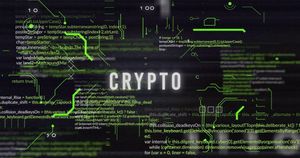XRP Poised for Major Trend Shift: Analysts Eye $4.00 Amidst Regulatory Clarity and Institutional Boom

San Francisco, CA – September 24, 2025 – The digital asset XRP is currently at the epicenter of a significant market shift, with prominent analysts forecasting a potential surge to $4.00 and beyond. This bullish sentiment is largely fueled by the definitive resolution of Ripple's protracted legal battle with the U.S. Securities and Exchange Commission (SEC) and a subsequent explosion in institutional adoption, positioning XRP as a critical bridge between traditional finance and the burgeoning digital economy.
The cryptocurrency market is abuzz with speculation regarding XRP's trajectory. Many experts are now pointing to technical indicators and fundamental developments that suggest a "major trend shift" is underway. This comes after years of regulatory uncertainty that largely suppressed XRP's growth, even as the broader crypto market experienced unprecedented rallies. The current consensus among analysts indicates that the legal clarity has unlocked XRP's potential, setting the stage for what could be a historic price appreciation in the coming months and years.
The Long Road to Clarity: A Timeline of Legal Battles and Market Reactions
The journey to XRP's current optimistic outlook has been a long and arduous one, primarily defined by its legal entanglement with the SEC. The lawsuit, initiated in December 2020, alleged that Ripple (XRP) conducted an unregistered securities offering. This legal cloud deterred many institutional investors and led to the delisting of XRP from several major exchanges, significantly impacting its market performance.
A pivotal moment arrived on July 13, 2023, when Judge Analisa Torres issued a summary judgment, ruling that programmatic sales of XRP on public exchanges were not unregistered securities, while direct institutional sales did constitute investment contracts. This mixed ruling was largely seen as a partial victory for Ripple, leading to an immediate and dramatic market reaction: XRP's price surged by an astonishing 87% in just three hours, reaching a high of $0.9327. Following this, the SEC initially pursued an interlocutory appeal in August 2023, which Judge Torres rejected in October 2023.
The final chapter of this legal saga concluded in August 2025, when Ripple and the SEC mutually dismissed their appeals, cementing the 2023 split ruling. This resolution involved Ripple paying a $125 million settlement to the U.S. Treasury, a significant reduction from the SEC's initial demand. This final legal clearance was met with a more modest, yet positive, market reaction, with XRP rallying roughly 5% intraday. However, unlike the immediate post-July 2023 surge, XRP's price has since been range-bound under $3.00, trading around $2.85-$2.88 at press time, despite peaking near $3.66 in July 2025. This suggests that while regulatory clarity is crucial, sustained growth will depend on broader adoption and utility.
Adding to the bullish sentiment, September 2025 witnessed the debut of the first U.S. spot XRP ETF, the REX-Osprey XRPR ETF (NASDAQ: XRPR), which recorded nearly $38 million in day-one trading volume. Furthermore, the CME Group announced it would offer options on XRP futures beginning October 13, signaling a significant turning point for institutional integration and liquidity.
Ripple's Resurgence: Winners and Losers in the New XRP Landscape
The newfound regulatory clarity for XRP has profound implications, primarily benefiting Ripple (XRP), the blockchain payments company behind the digital asset, and its extensive ecosystem. For years, the SEC lawsuit forced Ripple to focus its business outside the U.S. With the legal cloud lifted, Ripple is now aggressively re-entering the U.S. market, pursuing a New York banking charter and a Federal Reserve master account, which would allow it to compete directly with traditional banks in financial settlements.
Ripple's flagship On-Demand Liquidity (ODL) service, which leverages XRP for instant, low-cost cross-border settlements, is experiencing unprecedented growth. In Q2 2025 alone, ODL processed an astounding $1.3 trillion in cross-border transactions, demonstrating its efficiency in reducing operational costs for banks by 60-90% and accelerating transaction times from days to mere seconds. Key partners utilizing RippleNet or ODL include major players like Santander (BME: SAN), Bank of America (NYSE: BAC), and SBI Holdings (TYO: 8473). Ripple's strategic partnerships have also expanded, notably integrating its stablecoin RLUSD with BlackRock's (NYSE: BLK) BUIDL fund and VanEck's VBILL treasury product, creating seamless on-chain liquidity for tokenized funds. The company's acquisition of Metaco further strengthens its offerings in institutional blockchain applications.
While Ripple stands to be a significant winner, the competitive landscape in cross-border payments is intense. Traditional systems like SWIFT are exploring blockchain technologies, and other fintech solutions such as Airwallex, Hyperwallet (NASDAQ: PYPL), and Convera (formerly Western Union Business Solutions) continue to innovate. Other blockchain platforms like Stellar (XLM), Ethereum (ETH), and Bitcoin (BTC), particularly with its Lightning Network, also vie for market share. The increasing prominence of regulated stablecoins, including Ripple's own RLUSD, and Central Bank Digital Currencies (CBDCs) present both collaboration opportunities and competitive pressures, with stablecoins potentially enjoying a regulatory advantage in some markets.
Broader Implications: Reshaping Crypto Regulation and Institutional Finance
The resolution of the SEC vs. Ripple lawsuit is not merely a victory for one company; it is a landmark event that will send ripple effects throughout the entire cryptocurrency industry and traditional financial markets. This case has provided a critical template for applying the Howey Test to digital assets, establishing a crucial distinction between tokens sold to institutional investors as investment contracts and those traded on public exchanges. This nuanced interpretation is expected to influence future SEC enforcement actions, potentially leading to a more defined and less aggressive regulatory approach for the broader crypto market.
This newfound clarity has been a significant catalyst for institutional adoption of digital assets. Prior to the ruling, regulatory uncertainty deterred many traditional financial entities. With the legal cloud lifted, institutional confidence in XRP has been reinvigorated, leading to over $1.1 billion in institutional purchases recorded in 2025 alone. The successful launch of XRP Exchange-Traded Funds (ETFs), such as XRPR (NASDAQ: XRPR), mirrors the path taken by Bitcoin and Ethereum ETFs, further integrating digital assets into traditional investment vehicles and broadening access for institutional and retail investors.
Historically, financial innovation has consistently outpaced existing regulatory frameworks. The application of the Howey Test, a 1946 Supreme Court precedent, to XRP exemplifies how existing legal frameworks are stretched and reinterpreted to accommodate new technologies. Ripple's pursuit of a national bank charter and Federal Reserve master account echoes the trend of FinTech firms seeking to embed themselves within regulated financial systems to gain legitimacy and expand operations, aligning with historical instances where new financial services providers eventually sought or were compelled to obtain traditional licenses and oversight.
What Comes Next: Short-Term Gains and Long-Term Vision
The short-term outlook for XRP is overwhelmingly positive, with analysts anticipating a potential rally towards $3.00-$3.40 by Q3 2025, with more aggressive targets of $4.43-$7.90 if strong support levels are maintained and further ETF approvals materialize. Ripple's strategic pivots will focus on expanding its ODL service into high-growth corridors in Asia, Latin America, and the Middle East. The initial deployment of the XRP Ledger's (XRPL) native lending protocols and broader adoption of its compliance tools will enhance its institutional appeal, while liquid staking solutions like mXRP will begin to gain traction.
In the long term, XRP aims to solidify its position as a leading digital asset for global payments and a mainstream financial tool, acting as a crucial bridge between traditional and digital financial systems. Forecasts for 2030 range widely, from conservative estimates of $4.67 to highly optimistic projections surpassing $26, or even $50-$100, contingent on its dominance in cross-border payments and the evolution of the XRPL into a robust hub for tokenized assets, RWA markets, NFTs, and programmable layers. Ripple's ultimate ambition is to establish the XRPL as the institutional backbone for tokenized finance and a key facilitator for cross-border Central Bank Digital Currency (CBDC) transactions.
However, challenges remain. Incomplete global regulatory clarity, intense competition from other blockchain projects and traditional payment systems, and XRP's dependence on Ripple Labs' operational success are significant hurdles. The fact that institutions often use XRP as a momentary bridge asset in ODL transactions, rather than holding it long-term, could limit sustained direct buying pressure. Furthermore, the increasing role of Ripple's own stablecoin, RLUSD, could potentially divert utility away from XRP, impacting its price appreciation.
Comprehensive Wrap-Up: A New Chapter for XRP
The narrative surrounding XRP has fundamentally transformed. The conclusion of the SEC lawsuit has not only provided regulatory certainty but has also catalyzed a surge in institutional interest and adoption, positioning XRP for what many believe will be a major trend shift. The key takeaways are clear: regulatory clarity is paramount for institutional engagement, and XRP is now strategically positioned to bridge traditional finance with the digital asset economy through its ODL service, strategic partnerships, and the evolving XRP Ledger.
Moving forward, the XRP market is expected to exhibit increased volatility but with a strong underlying bullish sentiment. Its trajectory will be heavily influenced by the successful expansion of Ripple's ecosystem, the approval of more spot XRP ETFs, and the continued integration of the XRPL into real-world financial applications. The lasting impact of these developments is the establishment of a precedent for how digital assets can achieve regulatory compliance and mainstream acceptance, fostering a more predictable environment for innovation across the crypto industry.
Investors should closely monitor key price levels, particularly around the $1.91 support, as its ability to hold could signal bullish continuation. Staying informed on regulatory news, especially regarding pending XRP-spot ETF approvals, is crucial. It is also important to assess Ripple's continued expansion of its ODL service, new partnerships with financial institutions, and the growth of the XRP Ledger's ecosystem and use cases. While short-term price fluctuations are expected, the long-term outlook is increasingly tied to XRP's fundamental utility and institutional integration.
Disclaimer: This content is for informational purposes only and does not constitute financial advice. Investors should conduct their own research and consult with a qualified financial advisor before making any investment decisions.
More News
View More




Recent Quotes
View More
Quotes delayed at least 20 minutes.
By accessing this page, you agree to the Privacy Policy and Terms Of Service.